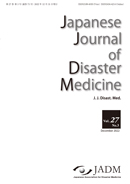Volume 27, Issue 3
Displaying 1-8 of 8 articles from this issue
- |<
- <
- 1
- >
- >|
Review article
-
2022 Volume 27 Issue 3 Pages 207-213
Published: December 08, 2022
Released on J-STAGE: December 08, 2022
Download PDF (407K)
Original article
-
 2022 Volume 27 Issue 3 Pages 195-200
2022 Volume 27 Issue 3 Pages 195-200
Published: December 08, 2022
Released on J-STAGE: December 08, 2022
Research report
-
 2022 Volume 27 Issue 3 Pages 165-172
2022 Volume 27 Issue 3 Pages 165-172
Published: October 12, 2022
Released on J-STAGE: October 12, 2022
-
2022 Volume 27 Issue 3 Pages 188-194
Published: November 12, 2022
Released on J-STAGE: November 12, 2022
Download PDF (480K)
Case report
-
2022 Volume 27 Issue 3 Pages 161-164
Published: September 30, 2022
Released on J-STAGE: September 30, 2022
Download PDF (1075K) -
2022 Volume 27 Issue 3 Pages 173-180
Published: October 12, 2022
Released on J-STAGE: October 12, 2022
Download PDF (1198K) -
2022 Volume 27 Issue 3 Pages 201-206
Published: December 08, 2022
Released on J-STAGE: December 08, 2022
Download PDF (739K)
Experience report
-
2022 Volume 27 Issue 3 Pages 181-187
Published: October 22, 2022
Released on J-STAGE: October 22, 2022
Download PDF (354K)
- |<
- <
- 1
- >
- >|
